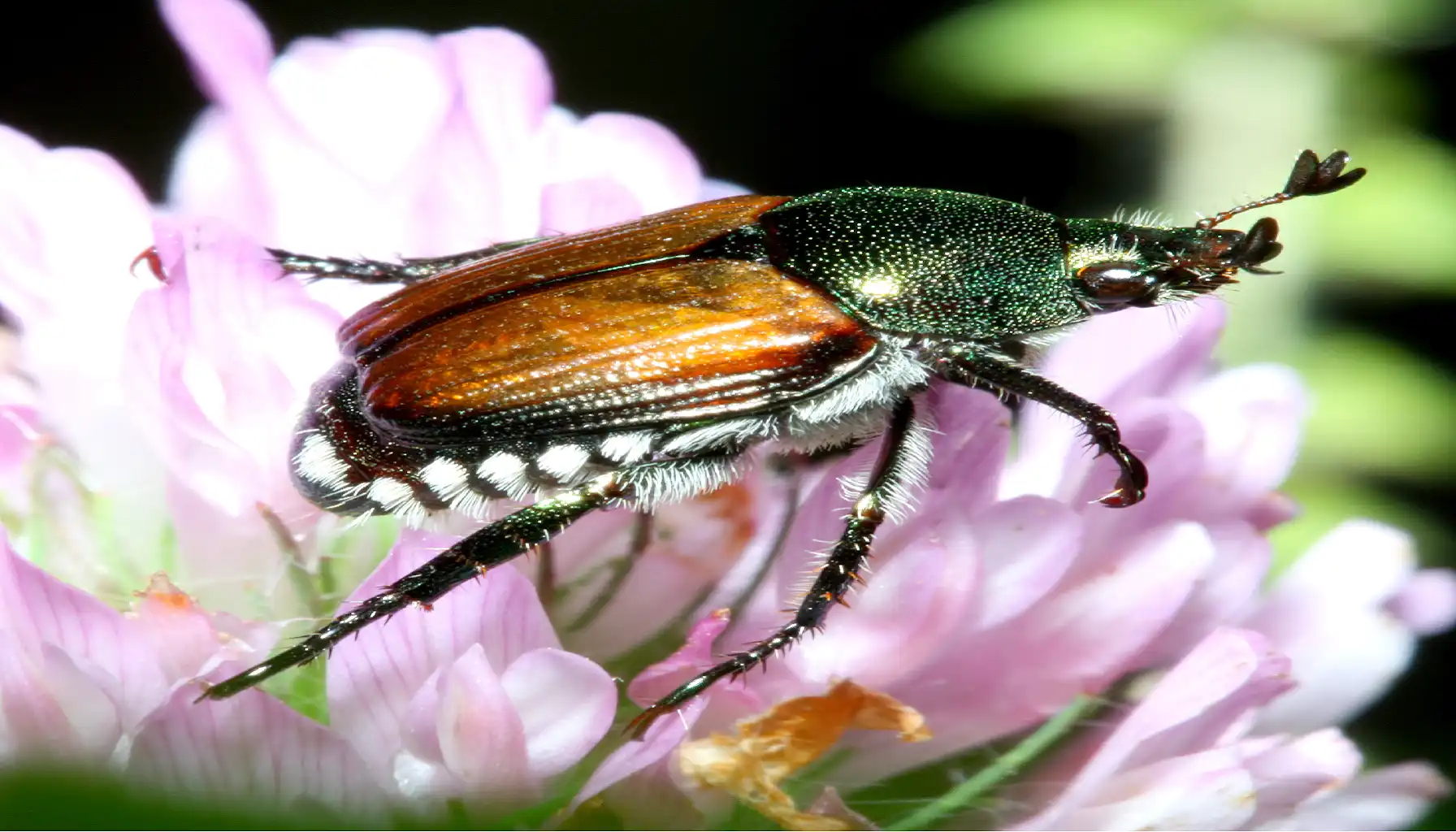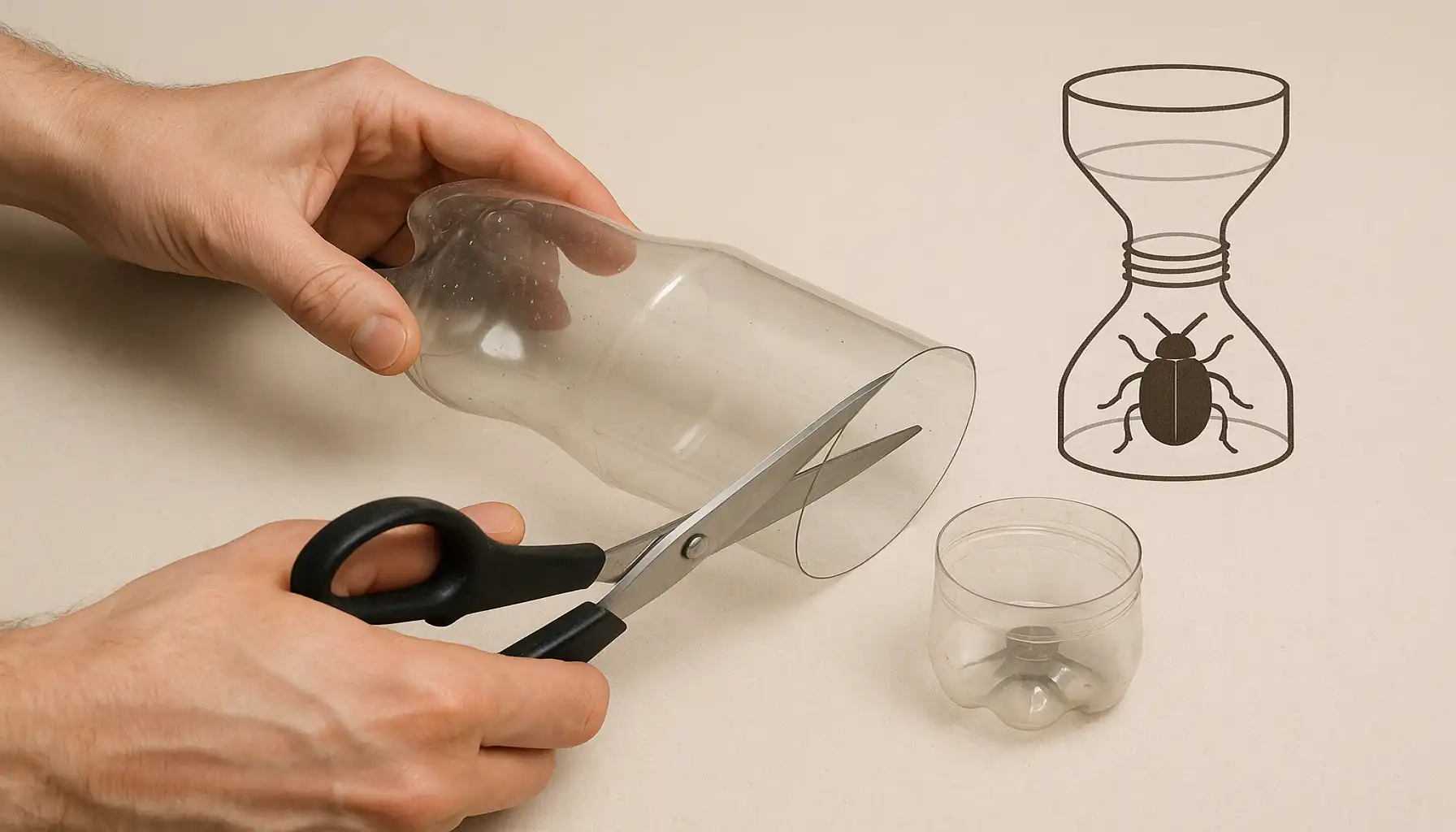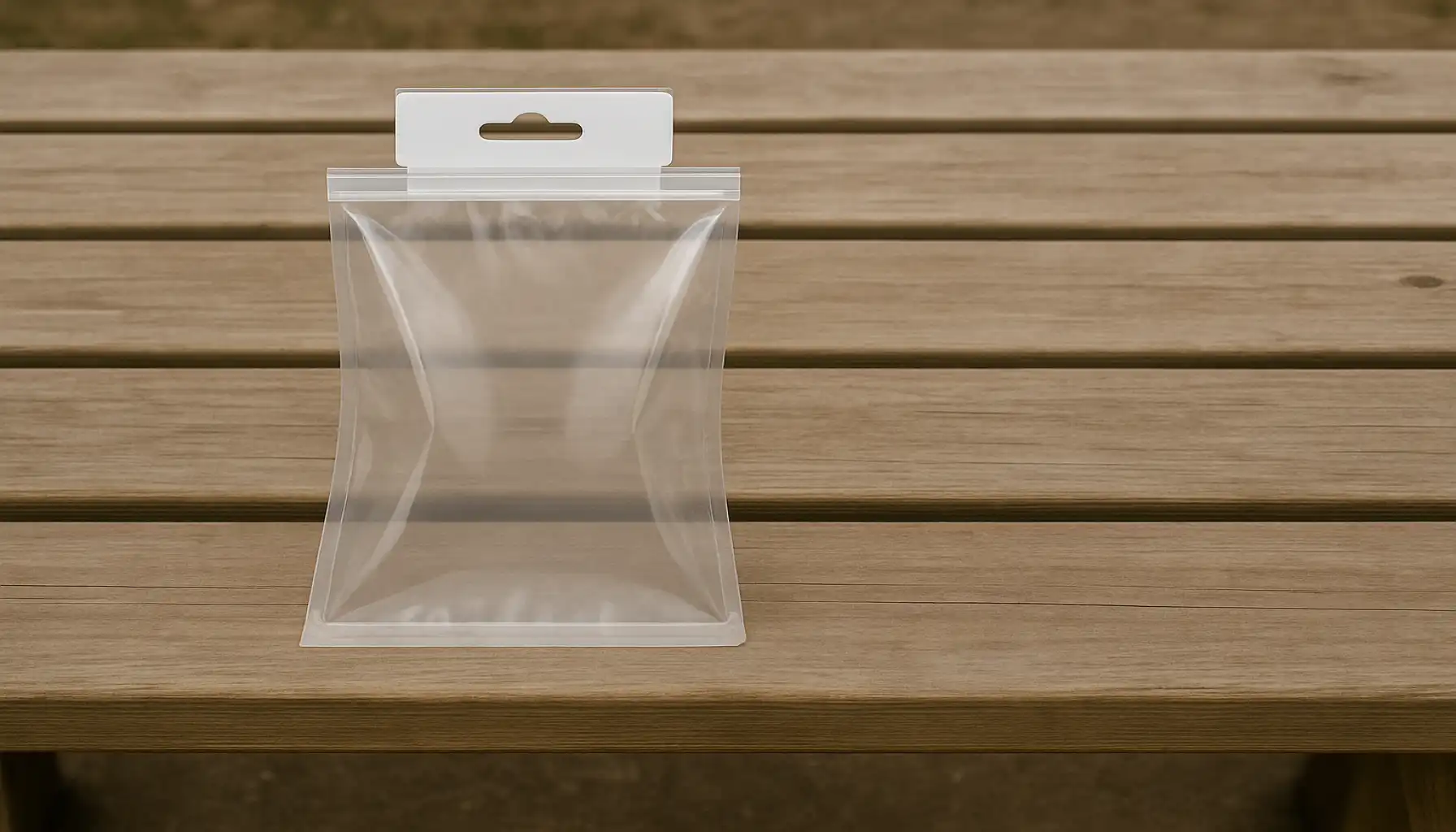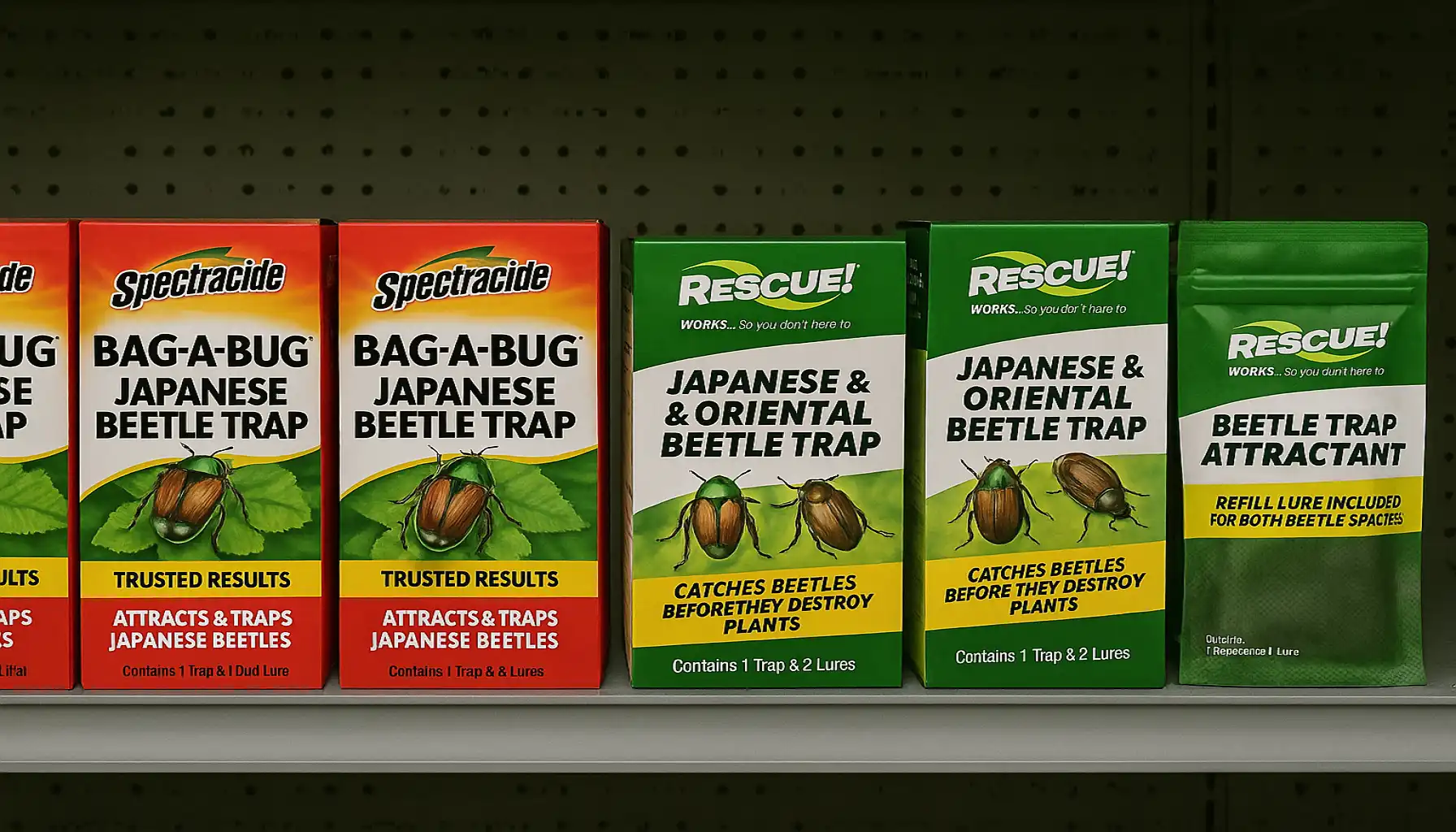.Japanese beetles can strip your roses, roses can lose all their leaves. These pests feed on flowers, fruits, and foliage. You see ragged edges and bare stems almost overnight. You need fast action to protect your plants and your harvest.
This guide shows you the best Japanese beetle traps and how to use them for maximum effect. You will learn how to choose the right snare, where to place it, and when to check it. You will also find tips to reduce coleopteran numbers without harming other insects. For quick help identifying plants in your garden, try a plant identifier free tool.
Homemade Japanese Beetle Traps That Actually Work
You can build a homemade japanese beetle trap using simple household items. Cut a soda bottle diy trap with a few angled holes near the top. Hang it from a branch over infested plants. Fill the bottle with soapy water mixed with bait. The pests fall in and cannot escape.
Learn how to make a beetle trap by using fruit or yeast as lure. Mix overripe fruit chunks and a pinch of yeast in water. Place the bait at the bottom of your snare. The scent draws beetles in quickly. Check and empty the snare daily for best results.
Opt for a natural japanese beetle trap instead of chemicals in your garden. These DIY devices avoid harming beneficial insects.You protect pollinators while cutting pest numbers. You also save money on store-bought solutions. The approach keeps your garden eco-friendly—learn more about balancing bugs and blooms in our Why Wasps Do Matter: Benefits of Wasp Presence in the Garden guide.
DIY Materials You’ll Need
2-liter soda bottle: Serves as a sturdy, reusablesnare container.
Scissors or knife: Cuts holes for entry and bait access.
Wire or string: Hangs the snare at the right height in your plants.
Fruit or yeast bait: Attracts coleopterans into the bottle for easy removal.
How to Assemble, Set Up, and Use Japanese Beetle Traps Correctly
Follow clear beetle trap instructions to build your device. First, unfold the snare panels and snap them into place per the diagram. Clip or tie the collecting bag below the funnel. Attach the lure pouch inside the snare chamber.
Placement makes a big difference when you learn how to set up beetle trap properly. Hang the snare at head height at least 30 feet away from valuable plants. Avoid putting it directly over vegetable beds, which risks drawing pests in. Check the snare daily and empty captured coleopterans into soapy water.
Refer to catchmaster japanese beetle trap instructions for maintenance tips. Replace the lure every two weeks for consistent attraction. Clean the funnel and bag before each refill to keep airflow clear. Store indoors during heavy rain to prevent dilution of the bait.
Location | Effectiveness | Notes |
30 feet from garden | ✅ High | Lures beetles away from plants |
Near flowering trees | ⚠️ Medium | May attract more beetles |
Next to vegetables | ❌ Low | Risks drawing in beetles |
Top-Rated Japanese Beetle Traps: A Brand Comparison
Many gardeners trust the spectracide bag-a-bug japanese beetle trap for its large yard coverage and combined pheromone + floral lure. The catchmaster japanese beetle trap uses a simple hanging design with a sticky panel to catch mid-sized invasions.
For home orchards, the rescue japanese beetle trap features a dual-action lure in a durable hanging snare. Those who prefer a low-impact method often choose the safer brand japanese beetle trap, which relies solely on pheromones and a compact sticky panel ideal for patio use.
If you need a budget-friendly option, try the classic bag-a-bug japanese beetle trap, which offers easy setup and disposal. Small gardens benefit from the bonide japanese beetle trap, a floral-lure disposable bag. For professional growers, the trecÉ japanese beetle trap brings high-strength lures in reusable bags. Finally, the tanglefoot japanese beetle trap uses a sticky coating on panels to snag quietly around seedlings and flower beds.
Brand | Lure Type | Trap Type |
Spectracide | Pheromone + Floral | Bag Trap |
Rescue | Dual-Action Lure | Hanging Trap |
Safer Brand | Pheromone | Sticky Panel |
Bonide | Floral Lure | Disposable Bag |
How Japanese Beetle Pheromone Traps Work
A japanese beetle pheromone trap uses synthetic sex attractants plus floral scents to lure adult beetles into a capture chamber. The lure mimics the natural pheromone released by female during mating season. Over time, the scent plume draws pests from surrounding plants. Replace spent attractants with a japanese beetle trap replacement lure every two weeks for consistent catch rates.
Home gardeners often choose branded refill packs like the spectracide bag-a-bug japanese beetle trap replacement lure for its dual-action formula. Organic growers may opt for safer japanese beetle trap bait, which relies on pheromone without synthetic pesticides. Snares work best when deployed in late spring through midsummer, during warm afternoons when feed most actively.
Traps, Refills, Bags, and Stands: Essential Accessories
Most snares require fresh japanese beetle trap refills each season to stay effective. You simply open the lure pouch, replace it, and seal the snare again. Regular refills ensure that the pheromone and floral scent remain strong enough to lure pests away from your plants.
If you use a Rescue model, look for rescue japanese beetle trap refills designed to snap into the hanging hopper. These dual-action lures combine feeding and sex attractants in one easy pack. Swapping them out every two weeks keeps capture rates high without extra work.
You can also upgrade with japanese beetle trap bags and a sturdy japanese beetle trap stand for long-term use. Extra bags let you empty catches quickly and hygienically. A metal stand holds bag at the ideal height and keeps them off the ground, extending their lifespan. Discover more gear-based tips in Pest Control: Essential Strategies and Regulations.
Accessory | Compatible Brands | Reusability |
Replacement Lures | Spectracide, Rescue | Seasonal use |
Trap Bags | Safer, Bonide | Single use |
Trap Stands | Spectracide, Catchmaster | Long-term |
Unusual Trap Setups: Chickens, Indoors & Alternatives
Some gardeners hang a japanese beetle trap for chickens inside their coop. Hens scratch and peck at the fallen bugs for an easy snack. You can also try an indoor japanese beetle trap to guard potted plants in a sunroom. A japanese lady beetle trap helps you catch and release beneficial without harming them.
Alternative Beetle Control Ideas
Let chickens feast on contents
Place snares near doors to reduce entry
Use yellow sticky boards for lady
Where to Buy the Best Japanese Beetle Traps Near You
Searching for a japanese beetle trap near me brings up local garden centers and hardware stores. You can compare prices and see display models in person. Many gardeners swear by the best Japanese beetle trap brands on the shelf for reliable pest control.
If you prefer online shopping, look for a trap for Japanese beetle on major retail sites. You’ll often find the spectracide japanese beetle trap starter kits bundled with extra lures. Shopping online lets you read reviews and choose between different lure types and styles.
For a complete solution, try the spectracide bag a bug Japanese beetle trap system. It offers reusable bodies and affordable refill packs. Decide between starter kits that include everything or refill-only packs that save money on long-term use.
Frequently Asked Questions
How effective are homemade traps compared to commercial ones?
DIY snares catch many beetles when placed correctly. They work best as a supplementary method. Commercial ones often use stronger lures for higher catch rates.
Can I reuse trap bags and lures?
You can clean and reuse hard plastic. Replace disposable bags after one use. Swap lures every two weeks for fresh attraction.
Do these traps attract more beetles to my yard?
Lure beetles from nearby areas. Place them away from prized plants. Proper placement sends beetles toward, not your flowers.
Are pheromone traps safe for other insects?
Pheromone snares target only Japanese. They rarely catch bees or butterflies. Still, monitor non-target catches and relocate if needed.
When should I set snares?
Install them in late spring when coleopterans first appear. Check daily through midsummer. Remove the devices once captures taper off.
Can I keep them out in rainy weather?
Most units hold up in light rain. Shield the bait under foliage or eaves. Avoid flooding the collection chamber in heavy downpours.
Do these methods work in large gardens?
They scale by number. You may need multiple units for larger spaces. Combine with hand-picking for complete coverage.
Is it safe to compost captured pests?
Never compost live specimens. First humanely euthanize via drowning or freezing. Then their remains can go into the compost safely.
Simplify Pest Control with AI Plant Finder
Tackling Japanese beetle damage gets easier with the right snares and placement. You can combine homemade and commercial options for best results. For plant care beyond pest control, use AI Plant Finder. Snap a leaf photo to identify plants and diagnose issues instantly—see how in What’s Wrong with My Plant – Quick Diagnosis & Ways Out.
AI Plant Finder Related Posts:







